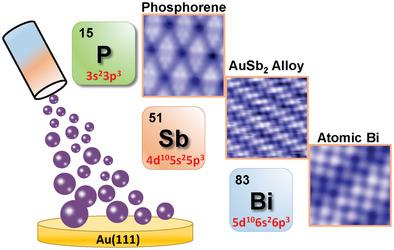当前位置:
X-MOL 学术
›
Adv. Mater. Interfaces
›
论文详情
Our official English website, www.x-mol.net, welcomes your
feedback! (Note: you will need to create a separate account there.)
Interfacial Effects on the Growth of Atomically Thin Film: Group VA Elements on Au(111)
Advanced Materials Interfaces ( IF 4.3 ) Pub Date : 2019-09-09 , DOI: 10.1002/admi.201901050 Dechun Zhou 1 , Nan Si 1 , Bohong Jiang 1 , Xiufeng Song 2 , Han Huang 3 , Qingmin Ji 1 , Tianchao Niu 1
Advanced Materials Interfaces ( IF 4.3 ) Pub Date : 2019-09-09 , DOI: 10.1002/admi.201901050 Dechun Zhou 1 , Nan Si 1 , Bohong Jiang 1 , Xiufeng Song 2 , Han Huang 3 , Qingmin Ji 1 , Tianchao Niu 1
Affiliation

|
The understanding of growth mechanism at atomic scale is a key issue for realizing wafer‐scale, high‐quality 2D materials, in which their interfaces play a crucial role. Here, the adsorption and the aggregation of group VA elements within the first layer on Au(111) are investigated. Together with recent results for group VA elements on Cu and Ag(111), this study leads to a comprehensive understanding of the interfacial effects on the surface structures. Blue phosphorene forms the typical (4 × 4) honeycomb structure on Au(111) regardless of the coverage. Sb assembles into multiple intermediate phases comprising dimer pairs and coin‐shaped aggregates depending critically on the coverage. Increasing the coverage and annealing temperature converts these dimer pairs to AuSb2 surface alloy. The honeycomb structure and periodic stripes are the most stable of Bi on Au(111). Notably, neither P nor Bi prefers surface alloy under the similar growth conditions even though they have the smaller and larger atomic radius, higher and lower electronegativity than Sb, respectively. This difference is correlated with the relativistic effect that tightly bound inner 6s2 electrons make Bi inert. These model systems provide guidance framework for selection of elements and substrates to synthesize monoelemental and binary 2D materials.
中文翻译:

原子薄膜生长的界面效应:Au(111)上的VA组元素
对原子级生长机理的理解是实现晶圆级高质量2D材料的关键问题,在这些材料中,它们的界面起着至关重要的作用。在这里,研究了Au(111)上第一层中VA族元素的吸附和聚集。结合铜和银(111)上的VA组元素的最新结果,该研究导致对界面对表面结构的影响的全面理解。无论覆盖率如何,蓝色磷光体都会在Au(111)上形成典型的(4×4)蜂窝结构。锑主要取决于覆盖范围,组装成由二聚体对和硬币状聚集体组成的多个中间相。增加覆盖率和退火温度可将这些二聚体对转化为AuSb 2表面合金。这 蜂窝结构和 周期条纹是Bi在Au(111)上最稳定的条纹。值得注意的是,尽管P和Bi的原子半径分别比Sb小和大,电负性高和低,但在相似的生长条件下,P和Bi都不优选表面合金。这种差异与紧密结合内部6s 2电子使Bi惰性的相对论效应相关。这些模型系统为合成单元素和二元2D材料的元素和基底的选择提供了指导框架。
更新日期:2019-09-09
中文翻译:

原子薄膜生长的界面效应:Au(111)上的VA组元素
对原子级生长机理的理解是实现晶圆级高质量2D材料的关键问题,在这些材料中,它们的界面起着至关重要的作用。在这里,研究了Au(111)上第一层中VA族元素的吸附和聚集。结合铜和银(111)上的VA组元素的最新结果,该研究导致对界面对表面结构的影响的全面理解。无论覆盖率如何,蓝色磷光体都会在Au(111)上形成典型的(4×4)蜂窝结构。锑主要取决于覆盖范围,组装成由二聚体对和硬币状聚集体组成的多个中间相。增加覆盖率和退火温度可将这些二聚体对转化为AuSb 2表面合金。这 蜂窝结构和 周期条纹是Bi在Au(111)上最稳定的条纹。值得注意的是,尽管P和Bi的原子半径分别比Sb小和大,电负性高和低,但在相似的生长条件下,P和Bi都不优选表面合金。这种差异与紧密结合内部6s 2电子使Bi惰性的相对论效应相关。这些模型系统为合成单元素和二元2D材料的元素和基底的选择提供了指导框架。











































 京公网安备 11010802027423号
京公网安备 11010802027423号